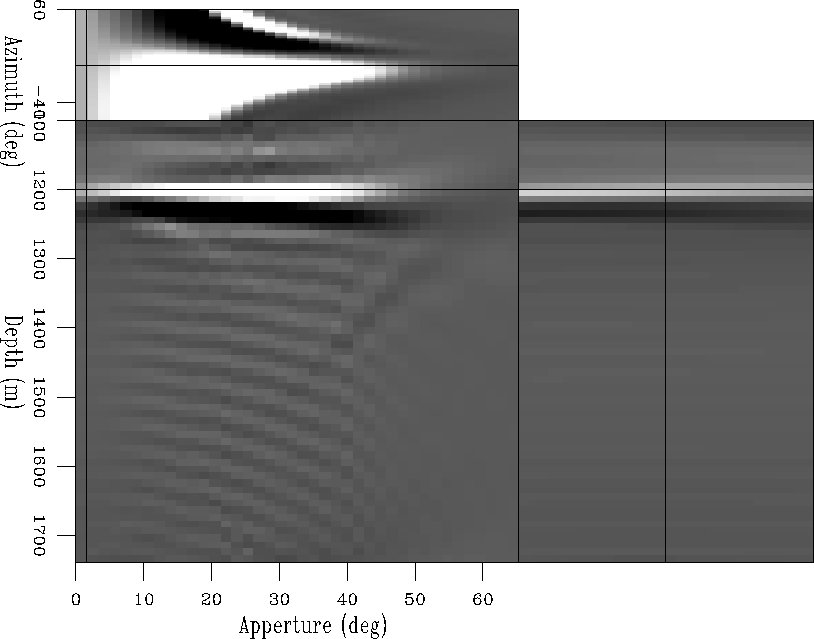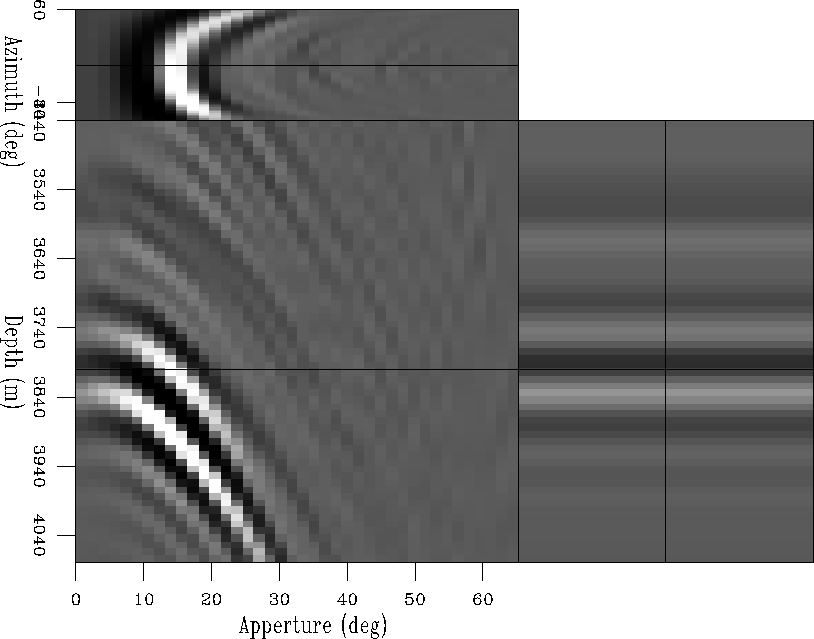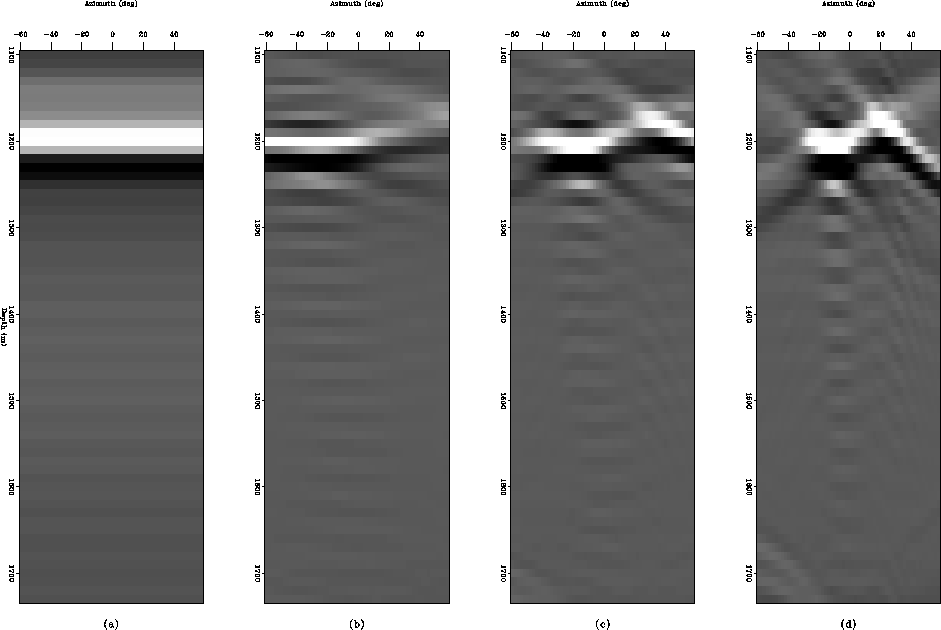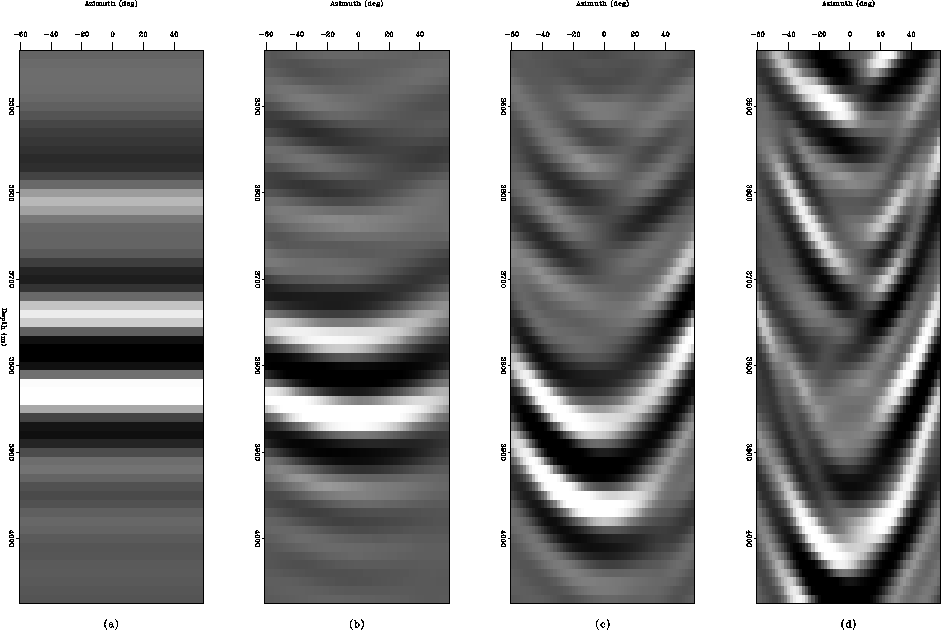




Next: Discussion
Up: Alvarez and Biondi: 3D
Previous: Transformation to pseudo 3D
The mathematical formalism and the methodology for computing true 3D ADCIGs
as a function of the aperture angle  and the data azimuth
and the data azimuth  was given by Biondi and Tisserant 2004. They showed
that the ADCIGs as a function of the aperture angle, for a fixed azimuth,
may depart from flat even for migration using the correct velocity. As function
of azimuth, the curvature of the events increase with increasing aperture
angle. For a fixed depth, this translates into an azimuth rotation which
depends on the dip of the reflector at that depth.
was given by Biondi and Tisserant 2004. They showed
that the ADCIGs as a function of the aperture angle, for a fixed azimuth,
may depart from flat even for migration using the correct velocity. As function
of azimuth, the curvature of the events increase with increasing aperture
angle. For a fixed depth, this translates into an azimuth rotation which
depends on the dip of the reflector at that depth.
An important issue is to evaluate the degree of azimuth rotation difference
between the water-bottom primary and the water-bottom multiple. Because
of computational ease, we first windowed the SODCIGs in depth and computed the
ADCIGs for the water-bottom primary only. Figure ![[*]](http://sepwww.stanford.edu/latex2html/cross_ref_motif.gif) shows the result for the same ADCIG as in Figure
shows the result for the same ADCIG as in Figure ![[*]](http://sepwww.stanford.edu/latex2html/cross_ref_motif.gif) . It is flat
for a given azimuth although the range of aperture angles is a function of
the azimuth.
. It is flat
for a given azimuth although the range of aperture angles is a function of
the azimuth.
Similarly, we windowed the water-bottom multiple and computed the
ADCIG as shown in Figure ![[*]](http://sepwww.stanford.edu/latex2html/cross_ref_motif.gif) . The depth slice shows
a small azimuth rotation when compared with the primary (compare the symmetry
of the top panels of Figures
. The depth slice shows
a small azimuth rotation when compared with the primary (compare the symmetry
of the top panels of Figures ![[*]](http://sepwww.stanford.edu/latex2html/cross_ref_motif.gif) and
and ![[*]](http://sepwww.stanford.edu/latex2html/cross_ref_motif.gif) ).
).
3dadcig1
Figure 16 3D ADCIG at a fixed spatial position for the
water-bottom primary.




 3dadcig2
3dadcig2
Figure 17 3D ADCIG at a fixed spatial position for the
water-bottom multiple.





It is interesting to analyze the angle gathers as a function of azimuth
for given aperture angles. The water-bottom primary and the water-bottom
multiple behave very differently as shown in Figures ![[*]](http://sepwww.stanford.edu/latex2html/cross_ref_motif.gif) and
and ![[*]](http://sepwww.stanford.edu/latex2html/cross_ref_motif.gif) . For the primary, as the aperture angle increases,
the angle gather as a function of azimuth loses its flatness and curves
down as shown in Biondi (2005). For the multiple, however, as the
aperture angle increases the gather as a function of azimuth curves up
because it is overmigrated.
. For the primary, as the aperture angle increases,
the angle gather as a function of azimuth loses its flatness and curves
down as shown in Biondi (2005). For the multiple, however, as the
aperture angle increases the gather as a function of azimuth curves up
because it is overmigrated.
az_gath1
Figure 18 3D ADCIG for the primary water-bottom reflection
as a function of azimuth. The different panels correspond to different aperture
angles: (a) 0, (b) 10, (c) 20 and (d) 30 degrees.




 az_gath2
az_gath2
Figure 19 3D ADCIG for the water-bottom multiple reflection
as a function of azimuth. The different panels correspond to different aperture
angles: (a) 0, (b) 10, (c) 20 and (d) 30 degrees.










Next: Discussion
Up: Alvarez and Biondi: 3D
Previous: Transformation to pseudo 3D
Stanford Exploration Project
4/6/2006
![[*]](http://sepwww.stanford.edu/latex2html/cross_ref_motif.gif) shows the result for the same ADCIG as in Figure
shows the result for the same ADCIG as in Figure ![[*]](http://sepwww.stanford.edu/latex2html/cross_ref_motif.gif) . It is flat
for a given azimuth although the range of aperture angles is a function of
the azimuth.
. It is flat
for a given azimuth although the range of aperture angles is a function of
the azimuth.
![[*]](http://sepwww.stanford.edu/latex2html/cross_ref_motif.gif) shows the result for the same ADCIG as in Figure
shows the result for the same ADCIG as in Figure ![[*]](http://sepwww.stanford.edu/latex2html/cross_ref_motif.gif) . It is flat
for a given azimuth although the range of aperture angles is a function of
the azimuth.
. It is flat
for a given azimuth although the range of aperture angles is a function of
the azimuth.
![[*]](http://sepwww.stanford.edu/latex2html/cross_ref_motif.gif) . The depth slice shows
a small azimuth rotation when compared with the primary (compare the symmetry
of the top panels of Figures
. The depth slice shows
a small azimuth rotation when compared with the primary (compare the symmetry
of the top panels of Figures ![[*]](http://sepwww.stanford.edu/latex2html/cross_ref_motif.gif) and
and ![[*]](http://sepwww.stanford.edu/latex2html/cross_ref_motif.gif) ).
).


![[*]](http://sepwww.stanford.edu/latex2html/cross_ref_motif.gif) and
and ![[*]](http://sepwww.stanford.edu/latex2html/cross_ref_motif.gif) . For the primary, as the aperture angle increases,
the angle gather as a function of azimuth loses its flatness and curves
down as shown in Biondi (2005). For the multiple, however, as the
aperture angle increases the gather as a function of azimuth curves up
because it is overmigrated.
. For the primary, as the aperture angle increases,
the angle gather as a function of azimuth loses its flatness and curves
down as shown in Biondi (2005). For the multiple, however, as the
aperture angle increases the gather as a function of azimuth curves up
because it is overmigrated.

